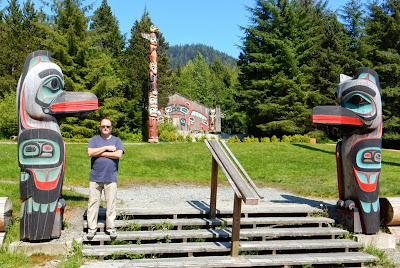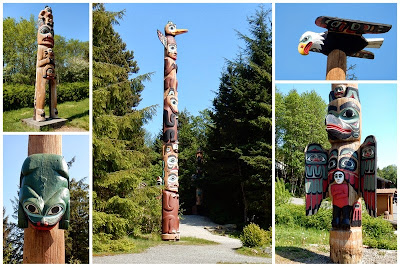It seems
that this is the summer for a huge number of RVers to make the journey to
Alaska. One couple is writing about
their journey in the blog Coloring the Void, which I have begun to follow. A recent post really hit home with me. “The RV Life” perfectly captures what our RV
life is also about. The post describes
the three types of days that comprise RV life – traveling, touristing and
living. Finding a
balance between driving from one place to another, seeing the sights and
performing routine chores and errands can often be challenging. This is especially true for anyone making the
journey to Alaska.
It’s tempting
to try and see everything there is to see since we don’t know if, or when, we
might be back to Alaska. However, just
like the rest of our full-time life, we have to remember to pace ourselves –
this is not a vacation for us, it’s our life.
Although we may do more and go more than we are used to, we don’t want
to burn out. Sensory overload is not
good either, and we certainly don’t want all the places to blur together. We want to be able to appreciate every stop,
even if it means we miss some things that are typical “must sees.”
It’s for
this reason that Monday for us was a “living” day. After our whirlwind day of flightseeing and
touring on Sunday, we stayed around the RV, gazed out at the water, did a load
of laundry, wrote a blog post and simply relaxed. It was a perfect way to spend the day. I’m so glad that we have several days between
ferry trips to be able to see each town at a slower pace.
We took our
time on Tuesday morning while checking out of the campground. It was foggy and we were in no hurry. We would be catching the ferry from Ketchikan
to Wrangell, but it wouldn’t leave until 3:15 am. Ugh! Our
plan was to spend the early part of the night camped at the ferry dock.
But
before that we had two stops planned – Totem Bight State Park and Saxman Totem
Park. Both feature totem poles and clan
houses, and they share a similar history.
In 1938 the Civilian Conservation Corp removed totem poles from abandoned
villages and established totem parks, including those in Totem Bight and Saxman. In most cases Native Alaskans working for the
CCC duplicated the original totems using traditional methods. The original poles were then discarded. This program helped train a new generation of
carvers and fostered an appreciation for Native art.
Totem
Bight is a now a state park that recreates a model Native village. A clan house, or community house, that is representative
of the type built during the early nineteenth century is the centerpiece. Fourteen totem poles surround the clan house,
and a self-guided tour brochure describes the story behind each one.
 |
| Totem Bight State Park |
 |
| Clan House |
 |
| Main Entrance |
 |
| A Beautiful Setting |
Located
within the context of a thriving Alaska Native community, Saxman Totem Park contains
the largest number of standing totems in one location and includes examples of
the best totem pole carvings in southern Southeastern Alaska. Totem poles are strategically placed on both
sides of the road that leads to the park-like setting that contains the clan
house. Most tourists visit Saxman on
cruise ship tours, and we arrived just as two buses were about to depart. We caught the tail end of a presentation by a
young Tlingit carver and saw several totem poles that were in different stages
of completion.
 |
| Approaching Saxman Totem Park |
 |
| Clan House |
 |
| That's an Odd Totem |
 |
| Another Odd Figure |
 |
| The Tradition of Carving Totem Poles Is Kept Alive at Saxman |
It has
been interesting to learn about the various types of totem poles, as well as their
significance and the stories that they tell.
We especially enjoyed identifying the various symbolic characters that are
represented and often repeated on the various totems. The two totem parks provide a different
experience than the one at the Totem Heritage Center, and I’m glad we decided
to visit all three.
We spent
the early evening in downtown Ketchikan after all the cruise ships had
departed, and what a change it was. Most
of the shops were closed, and it seemed as if the town had rolled up the
sidewalk. It was then time to head to
the ferry dock and try to catch a nap before it was time to board the
ferry. Easier said than done, but we
survived.
I still can’t
believe the beautiful, sunny days we enjoyed in Ketchikan. May is one of the best times to visit Southeast
Alaska if you want to lessen the chance of rain. It certainly worked for us.
I’d like
to offer one last tip to any RVers who may be considering a stop in Ketchikan. Before we arrived, we had read that campground
water in Ketchikan contains tannins and is the color of tea. Although the water is potable, it’s not what
I wanted to run through our water filter or add to our fresh water tank. So, we filled our tank before boarding the
ferry in Prince Rupert and bought bottled water for drinking and coffee. (We almost never use bottled water, but our
tank is small and we would not have lasted without it.) We will refill our tank when we get to
Wrangell, our next stop.


I loved Ketchikan! Lucky you to be able to spend time there. Torrey still talks about the totems.
ReplyDeleteJane
Ketchikan was special, and the native heritage was so interesting. It doesn't surprise me that Torrey appreciated the totems.
DeleteThank you so much for the mention! It is so hard to explain to non-full-time people that we actually have to have down time and maintenance time. They wonder what we do all day...You explained it very well!
ReplyDeleteThank you. It was actually your post that hit the nail on the head, so to speak, for me. It is hard for most people to realize that we are not on vacation. This is our life.
Delete